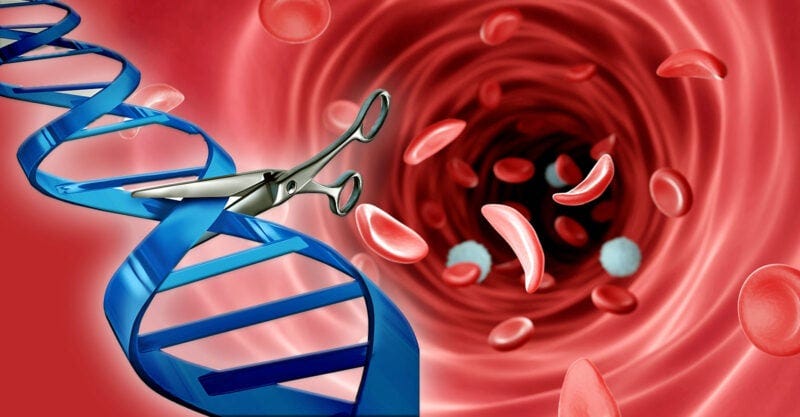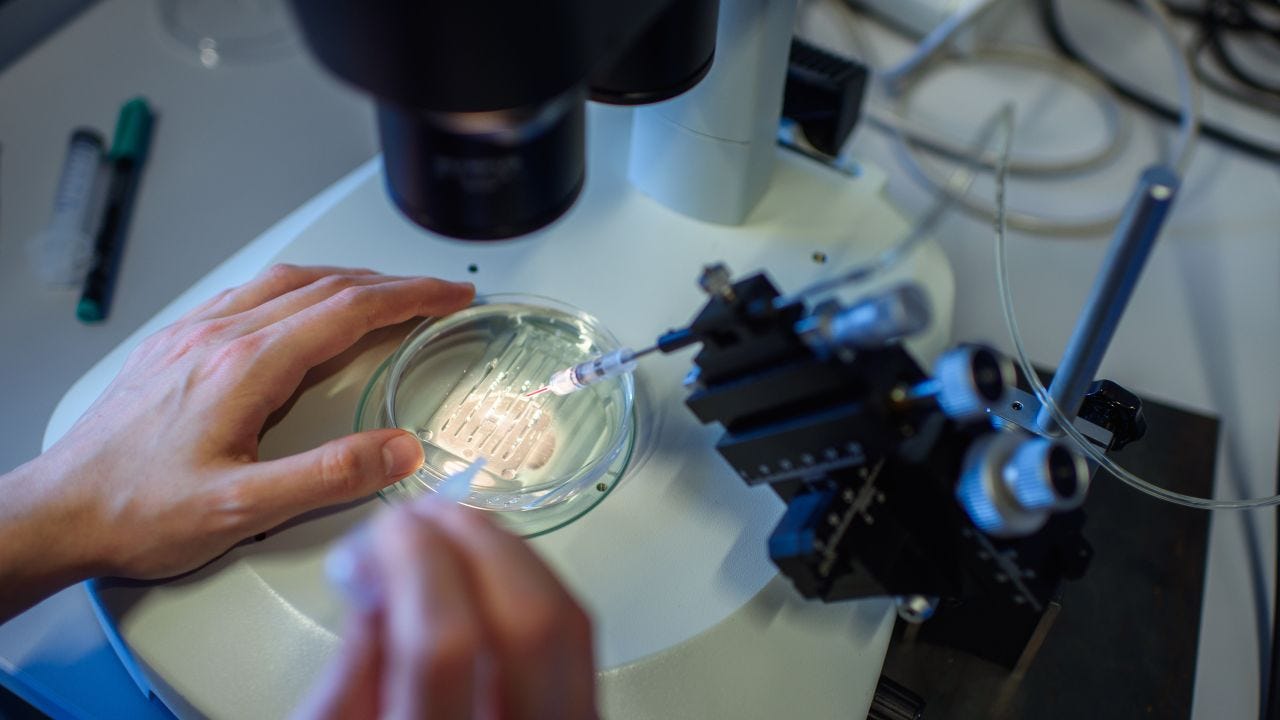Gene-Edited Humans? Scientists Sound Alarm as UK Approves CRISPR Therapy to Treat Blood Disease
U.K. regulators this week approved the first CRISPR therapy to treat humans and U.S. regulators could approve the therapy
Miss a day, miss a lot. Subscribe to The Defender's Top News of the Day. It's free.
U.K. regulators on Thursday approved a therapy that uses CRISPR gene editing technology to treat two blood disorders. U.S. federal regulators are poised to approve that same treatment in December.
The exa-cel therapy, which goes by the brand name Casgevy, is the world’s first CRISPR therapy for humans to be approved for the market.
CRISPR is a gene editing technology that acts as a pair of “genetic scissors,” allowing scientists to edit sections of DNA by “snipping” specific portions of it and replacing them with new segments. First announced in a 2012 paper, CRISPR is celebrated as a cheap and easy way to edit genes.
Its inventors won the Nobel Prize in chemistry in 2020. In recent years, applications in plant manipulation and research on possible use in humans have proliferated as the technology has been promoted as a potential solution to problems running from disease, to food security to climate change.
But that research has been highly controversial, and a long series of papers has been published detailing the unintended effects of CRISPR gene editing, which has been found to produce many types of serious unintended DNA damage.
Casgevy is designed to treat two blood conditions: sickle cell disease and beta thalassemia. Sickle cell disease, also known as sickle cell anemia, most commonly occurs in people of African or Caribbean descent. It can cause debilitating pain.
People with beta thalassemia, which can cause mild or severe anemia, can require regular blood transfusions.
Both genetic conditions are caused by errors in the genes for hemoglobin, a protein that lets red blood cells transport oxygen around the body — and both conditions can be fatal.
The therapy, developed by Vertex Pharmaceuticals and CRISPR Therapeutics, was approved after a sickle cell trial that followed only 29 out of a total of 45 participants for 16 months. Twenty-eight of those followed had no pain after one year, Nature reported.
In the clinical trial for beta thalassemia, 39 of the 42 trial participants did not need to have a red blood cell transfusion for at least 12 months after receiving Casgevy. They typically need blood transfusions every three to five weeks.
How does the treatment work?
For both diseases, the treatment is administered by taking blood-producing stem cells out of the patient’s bone marrow and editing the genes using CRISPR, also known as CRISPR/Cas9, named for the protein used to cut the DNA.
The technology targets a gene called BCL11A that typically disrupts the production of a kind of hemoglobin typically made only by fetuses.
The Cas9 locates the gene and cuts the DNA strands to make the gene stop working. In the process, it unleashes the production of fetal hemoglobin, which doesn’t have the same abnormalities as adult hemoglobin in people with those blood disorders.
Prior to treatment, patients undergo an intense and risky treatment called “myeloablative conditioning,” which prepares their body to receive the gene-edited cells. The gene-edited cells are then infused back into the body after they are edited. Patients may need to spend months in the hospital before and after the treatment.
The treatment will likely be very expensive — roughly $2 million — as we enter the so-called “era of one-shot, multimillion-dollar genetic cures,” although the companies have not named the price.
‘It only takes one cell within large pool of edited cells to … cause cancer’
Although most media coverage celebrated new CRISPR-based treatments, scientific research has raised concerns about the use of the technology, which can cause serious genetic damage.
This can occur, for example, when the cell starts to repair itself after the initial CRISPR-targeted cut, regardless of how “precise” that cut may be.
Studies have found that CRISPR edits intended to knock out the function of a gene have failed to do so. Instead, they have damaged the genes, causing unknown mutations.
In other cases, CRISPR made unexpectedly large deletions, causing greater genetic damage than previously thought.
Michael Antoniou, Ph.D., head of the Gene Expression & Therapy Group at King’s College London, told The Defender:
“It is well established that CRISPR/Cas9 gene editing is not only prone to off-target genetic damage but also a wide range of unintended mutations even at the intended edit site. This can negatively impact the function of multiple genes, which can lead to cancer.
“It is thus vital that those responsible for administering the gene editing therapy conduct unbiased genome-wide analysis of treated patients for potentially life-damaging DNA mutations. This is essential as it only takes one cell within the large pool of edited cells to go wrong and cause cancer.”
The clinical trials didn’t find cancer in any of the subjects, but the test group was small and patients were followed for only 16 months. Vertex said it plans to follow clinical trial subjects for 15 years but told regulators they “saw no reason to hold the treatment back,” The New York Times reported.
U.S. Food and Drug Administration (FDA) advisory committee member Alexis Komor noted that there can always be additional safety studies, and it didn’t make sense to be “expecting perfection at the expense of progress.”
CRISPR for high cholesterol? CEO of biotech company developing treatment hopes someday everyone will take it
A second CRISPR medical treatment made headlines this week when researchers reported that 2 of 10 participants had heart attacks — and one of those died — in the first human trial using a CRISPR-derived technique known as “base editing” to reduce cholesterol.
Yet the study, presented at an American Heart Association meeting last Sunday, is being hailed as “a potential landmark proof-of-concept” by NPR and as showing “promising results” by Nature and as a “breakthrough” by Science because it reduced the amount of low-density lipoprotein (LDL), or “bad cholesterol” in the surviving trial participants’ blood by up to 55%.
Campamento Tortuguero Playa Hermosa is a turtle sanctuary on Bonfil Beach outside of Acapulco that rescues sea turtle eggs that would be likely destroyed by vehicles on the beaches or pilfered by tourists. The sanctuary protects the eggs, hatches them and releases the babies into the ocean while protecting them from seagulls and other winged predators.
The 35-year-old sanctuary is run by the mother/daughter duo of Monica and Michel Vallarino, who have helped educate the community and the tourists on the ecology of the turtles while simultaneously providing a refuge for puppies, kittens, ducks, rabbits, and other wayward animals.
The Art of Liberty Foundation hosted an annual fundraiser from 2018-2020 called the Art of Liberty on the Beach (aKa The Turtle Party), where many of the leading artists in the liberty movement have rocked the sanctuary including Grant "Prezence" Ellman, Truniversal/Free Willow, Alais Clay, the Freenauts, DJ Koala, DJ Ramiro Romani and ELA-mental among others.
The sanctuary was devasted by Hurricane Otis, a category five hurricane that hit Acapulco and Bonfil Beach on November 2nd 2023.
25% of Funds Raised Will Benefit Other Residents of Bonfil Beach
The Art of Liberty Foundation is organizing a fundraiser where 100% of the proceeds will go to direct relief. The Vallarinos have agreed to share 25% of the proceeds with other Bonfil Beach residents in need to be distributed at their discretion.








I’m baffled..... why are they even bothering to put this forward as a ‘treatment’ for blood diseases when Saving ANY of us is exactly the opposite to what’s actually on their agenda? … Surely I’d any of these medical monsters were in any way interested in making our lives better and healthier they wouldn’t have spent the last 70 years poisoning and torturing us all like Guinea pigs!